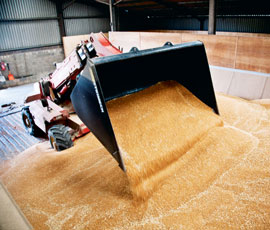Calculating gross margins for varieties aids selection

Next month will see the publication of the 2012-13 HGCA Recommended List. Louise Impey looks at how one agronomist uses the data to calculate gross margins for individual wheat varieties to aid variety selection.
Getting as big a pile of grain as possible, of the best quality, was the aim of most growers when it came to producing wheat.
“For this reason, it’s not surprising that the treated yield figure on the Recommended List is the one that draws the eye,” said independent agronomist Nick Wall of Crop Management Partners at a Limagrain press briefing this week.
The fact that an extra 5% of yield, which is equivalent to 0.5t/ha with yields at 10t/ha, was worth £75/ha at current grain prices, helped to explain the importance of yield, he added.
“It means that the high-yielding feed varieties tend to be the ones with the highest gross margins, especially when milling premiums are low, as they were in 2011. But that situation changes rapidly if these premiums rise, which is why it’s important to do the calculations.”
Milling varieties, with their required extra expenditure, may be judged to be too risky on some farms, he said.
Mr Wall points out that variety choice is driven by financial, physical and agronomic factors, with each having a different emphasis for individual farm businesses.
Physical factors tend to have a greater influence on larger farms than smaller units, he added. “Growing high risk varieties on outlying land, or putting later maturing varieties on drought-prone land, are two good examples of potential problems. Bigger businesses tend to go for the high yielding, low risk feed varieties.”
The agronomic strengths and weaknesses of different varieties will vary on a regional basis, but could be used to calculate growing costs and determine which varieties were likely to produce the best gross margins, noted Mr Wall.
He makes use of the RL disease resistance scores to plan his spray programmes, putting fungicide costs against the different spray timings according to the ratings. These are then added to the costs of fertiliser, growth regulators and insecticide use, to help determine the variety’s place on farm.
“If a variety has a disease resistance rating of below 5, I know it will need spraying for that disease in most seasons. I use that as the basis for planning and working out gross margins.”
At current prices, KWS Santiago will produce the highest gross margin of £1,340/ha (see table below), he predicted. “Compared with the other feed varieties, it needs a bit more expenditure at T0, to help with mildew, but it doesn’t have to be sprayed for orange wheat blossom midge. So it has a growing cost of around £82/ha.”
In contrast, Group 1 Solstice has a growing cost of £144/ha, he says. “Its rust susceptibility means that it needs a more expensive T0 and T1 spray, as well as late foliar nitrogen to get the required grain protein. So it comes out with a gross margin of £1,276/ha.”
However, that calculation is based on achieving a milling premium of £15/t. “If it rises to £25/t, then Solstice outperforms KWS Santiago on gross margin.”
Mr Wall concluded by pointing out that there wasn’t a huge difference between the growing costs of different varieties. “But it’s still worth looking at the scores. And for this coming year [late November], some of them will have changed.”

In the Limagrain pipeline
Three candidate spring barley varieties were looking very promising for Limagrain, reported the company’s head barley breeder Mark Glew.
Overture, Odyssey and Chronicle, all described as “sons of Concerto,” were at the top for both yield and quality, he claimed.
“They’ve got support from the IBD for both brewing and distilling and are in national trials throughout Europe. Such widespread adaptation demonstrates their performance stability.”
Meanwhile, candidate soft Group 4 wheat Horatio combined high yields with outstanding disease resistance, including a 7 for septoria, notes wheat breeder Ron Granger.
“It’s been rated positive for distilling and export, has good standing ability and orange wheat blossom midge resistance.”

